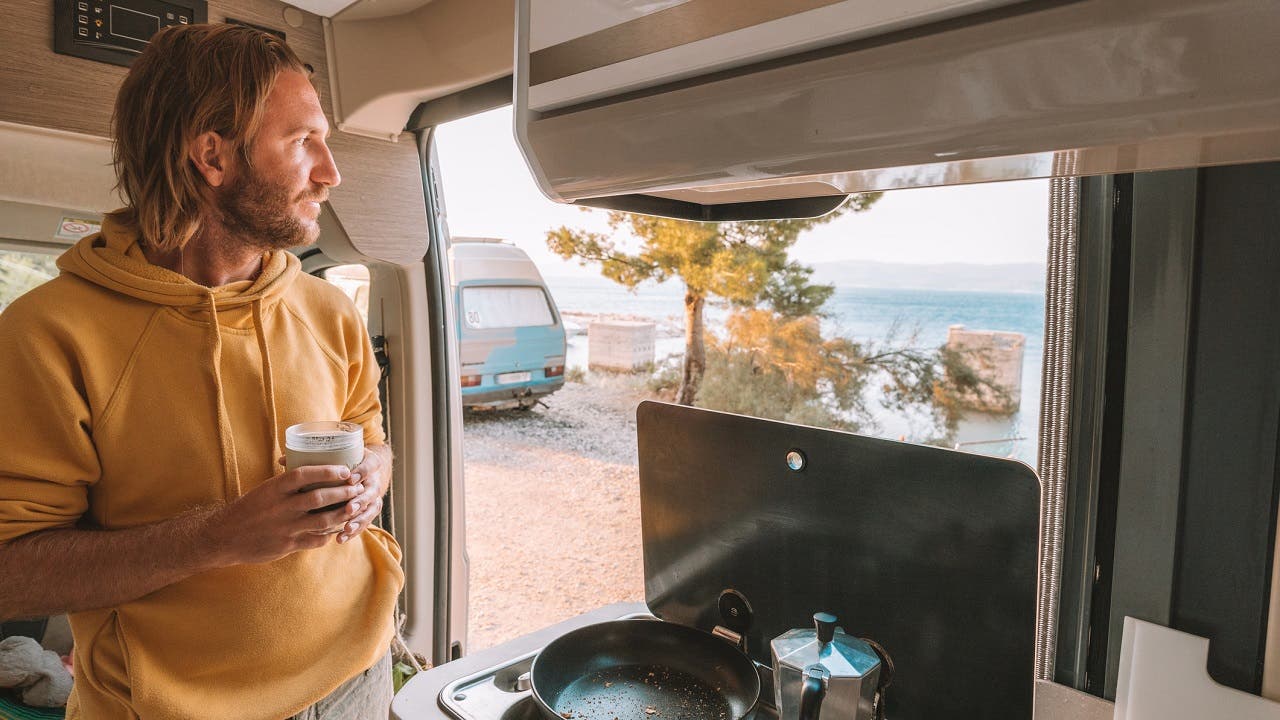
The Bankrate promise
At Bankrate we strive to help you make smarter financial decisions. While we adhere to strict , this post may contain references to products from our partners. Here's an explanation for .
Key takeaways
- The average cost of a house in the U.S. is about $357,300, whereas a new camper van starts at just $130,000.
- The cost of purchasing a van varies significantly depending on the make and model and whether it needs to be converted.
- Current van lifers spend around $1,000 to $3,000 per month in monthly expenses, making van life a more affordable way of living.
The number of van lifers in the United States has increased by 63 percent in the last couple of years, going from 1.9 million in 2020 to 3.1 million in 2022 — and it’s easy to see why.
Besides the appeal of being able to switch locations whenever you crave a change of scenery, van life is substantially more affordable than buying a home. According to Zillow, the average cost of a house in the U.S. is about $357,300. A new camper van, on the other hand, starts at just $130,000 and that number can go down substantially if you choose to buy a used model.
That said, van life isn’t dirt cheap either. There are some significant costs that interested adventurers must be ready to finance before taking the plunge.
- The number of American van lifers has increased by 63 percent over the last couple of years, going from 1.9 million in 2020 to 3.1 million in 2022.
- The most popular live-in vans have an average square footage of 126 square feet.
- The average cost per square foot of a new live-in van is $268. That means that the average live-in van costs about $33,768.
- The average cost of an older, used camper van is $25,000 or less.
- California, Colorado, Florida, Oregon and Washington are among the states with the largest population of van lifers in the country.
- The starting price of a DIY van conversion is a little over $2,000, while professional van conversions start at around $30,000 — excluding the cost of the van itself.
- Roughly 80 percent of van lifers do DIY conversions.
- Van life is particularly popular among millennials and younger Gen Xers. In a recent survey, those between the ages of 35 and 44 accounted for 31 percent of Americans who would consider joining the van life after the pandemic.
- Gas is the highest expense for most van lifers, eating away between $200 and $500 of their monthly budget.
- A new Mercedes-Benz Sprinter, one of the most popular live-in vans, costs about $45,800. Meanwhile, the average price of a home in Youngstown, Ohio — one of the cheapest cities for homebuying — costs $115,000. That’s more than double the price of the Sprinter van.
Boats, RVs and vans
Housing units have expanded further than vans, with boats and RVs coming into the fold. From 2011 to 2016, units counted as housing remained almost even, but there has been a sharp increase between 2017 and 2021.
How much does a van cost?
The cost of buying a van can vary dramatically, depending on the make and model of the vehicle and whether it needs to be converted.
You can find older, used vans for under $10,000 on average. However, a new van can set you back by $80,000 or more, depending on your desire.
Still, buying a van is more affordable than purchasing a home. For instance, the average price for a new 2023 Mercedes-Benz Sprinter (a rather popular van model) is around $45,800, according to Car and Driver. By contrast, the average price of a home in Youngstown, Ohio, one of the most affordable places to buy a home in the U.S., is $115,000.
Other popular van models among van lifers include Dodge Promasters, Ford Transits, VW Vanagons, buses and budget cargo vans. Budget cargo vans are generally one of the best for van life, as they’re a cheaper option to convert. Some popular brands include Ford Econolines, Chevy G Series, Chevy Express and Astros. These vehicles tend to be older and require some work to convert into living spaces.
| Vehicle type | Average cost new (2023) | Average cost used (2016) |
|---|---|---|
| Sprinter Van | $45,795 | $39,950 |
| Dodge Promaster | $40,635 | $15,999 |
| Ford Transit | $43,455 | $28,997 |
| Bus | $90,000 | $7,000 |
RV life costs
Another popular alternative to traditional housing is living in an RV. Although these tend to be more expensive than most vans, they’re also more spacious and can be easier to finance, as there are loans specifically for them.
- The average cost of an RV ranges from $35,000 to $300,000, depending on the vehicle’s class and amenities featured.
- Unlike vans, which can be bought with no down payment, RV companies require you to give at least 10 percent down of the cost of the vehicle, although many prefer a 20 percent down payment.
- Fifth wheels and travel trailers are the most inexpensive RVs, with new models starting at $10,000 and $15,000, respectively.
- Class A RVs are the most expensive, with some models costing about $1 million.
- The average monthly payment for an RV loan ranges from $225 to $650 — between two and eight times cheaper than the average mortgage payment for a house, which is $1,811.
Preparing for van life
Before deciding to take the leap into van life, it is important to consider all you need to do to prepare. Aside from preparing your van to be livable and making the proper accommodations for income, you must figure out what to do with your current home and where to store any possessions you can’t take with you on the road.
Current living space
If you rent your current residence, you only need to worry about when your current lease ends and speak with your landlord.
If you own a house or apartment, you may consider renting or selling the home. There are many factors to consider when deciding whether to rent or sell your home. Consider whether your transition to van life is temporary or permanent, if you need to tap into your home equity in the future, and whether you want to take on being a landlord and current home values in your area before deciding to rent or sell your home.
Personal belongings
Moving into a house on wheels also involves downsizing, and you may wonder what you should do with your belongings that won’t fit in your van. It comes down to how essential these items are and how likely you are to need them in the future.
You can rent a storage unit to house your belongings if you need to keep them. Selling or giving away what you do not need is likely a more cost-effective option.
Van conversion
Buying and converting a vehicle to live in can be expensive. Some vans have already been converted; these used vehicles can bring down the costs of a vehicle.
Paying in cash is probably the easiest route for buying and converting a van. It can be cost-effective to sell your home and/or other vehicle(s) and use the profits. Many people do not have the cash required for a major project like this on hand. If you do not have the cash to fund this project, consider asking the dealer who sold you your van about financing options.
If the dealership is unwilling to finance the vehicle conversion, there are also RV loans and unsecured personal loans available:
- RV loans are secured loans designed specifically for the purchase of recreational vehicles, using the vehicle itself as collateral. Lenders offer payment plans with term lengths up to 20 years.
- Unsecured personal loans are not backed by collateral, meaning you do not run the risk of losing your van if you cannot pay off the loan. The interest rates for unsecured personal loans tend to be higher, especially for those with poor credit. You can take out a personal loan for any purpose, making them ideal for a large recreational purchase like this.
Getting and converting a van
The cost of van life is more than the initial cost of the vehicle. Converting a van includes buying building materials, appliances and features and, depending on whether you plan to do the work yourself or not, labor costs.
The amount you spend depends entirely on the amenities you choose to include, where you buy your materials and the types of materials. Costs also depend on whether you hire a company to take care of the conversion or if you plan on doing it yourself.
DIY conversions tend to be less expensive than professional conversions. With the DIY approach, you could spend as little as $4,000, while professional companies can charge upwards of $100,000 to get the job done.
A modern van conversion that includes basic amenities typically costs between $5,000 to $15,000. This is just an estimate, however. Prices for top-rated van conversion companies tend to range from $12,000 to $35,000. The company you choose and how much work needs to be done will influence the cost.
The amenities you can include in your vehicle will depend on its capacity for plumbing and electrical. Solar panels tend to be the largest expense for van lifers, with an off-grid solar setup ranging from an average of $1,500 to $4,000. Bigger items like fridges for campervans and working plumbing also tend to be larger expenses.
Van life expenses
Once you have converted your vehicle, everyday expenses of van life also need to be considered. These expenses will largely depend on personal needs and habits.
Your weekly and monthly expenses depend largely on your eating and traveling habits. Some are easier to plan for, such as a gym membership to shower if you don’t have one in the van. Others come up depending on how much gas is at a given time or where you go to eat.
Current van lifers tend to spend anywhere from $1,000 to $3,000 on their monthly expenses, including insurance, camping and recreational fees and miscellaneous expenses, according to RV Blogger. Although these figures may seem shocking, it’s important to note that the cost of many goods and services has risen considerably due to high inflation over the last two years.
| Weekly/monthly van life expenses | Average cost |
|---|---|
| Gas | $200-$500 a week |
| Paid campsites | $300-$3,000+ (depending on the area/amenities included) |
| RV insurance | $80-$165 a month |
| Gym membership | $20-$30 |
| Groceries/food | $400-$1,000 |
Insurance
Taking out an insurance policy on your vehicle is important, adding a monthly expense to your budget. Insurance for recreational vehicles varies by provider and specific circumstances, but you can generally expect to pay between $80 and $165 a month for vehicle insurance.
Incidentals
You must plan for the worst when you are living life on the road, and that means putting money aside for vehicle repairs and any other emergency expenses that may come up. Having at least $500 set aside for emergencies is generally a good idea. It is better if you can set aside half a year’s worth of living expenses as an emergency fund.
Taxes
Paying state taxes can be complicated when you live in multiple states throughout the year. It may be a bit easier if a specific employer employs you, but freelancers who live on the road may want to consider hiring a professional to help sort out their state taxes.
Campsites
While the most economical choice is finding free campsites in your area, this may not always be feasible. Paid campsites run on an average of $10-$30 a night, meaning that if you stay at a paid campsite every night for a month, you will likely pay between $300 and $900 total.
The bottom line
Van life has become incredibly popular over the years, only increasing in popularity as the COVID-19 pandemic continues to be a reality of everyday life. People are looking to find adventure, freedom and fun in a socially distanced way.
The phenomenon of widespread remote work has given those with the financial freedom to do so a unique opportunity to hit the road permanently. However, buying, converting and living in a recreational vehicle is expensive and can be cost-prohibitive for many.
If you are thinking about taking the leap into van life, make sure that you are aware of all the costs and will be able to maintain your financial health and income along the way.
Related Articles




6 money moves that adults living with their parents should be making